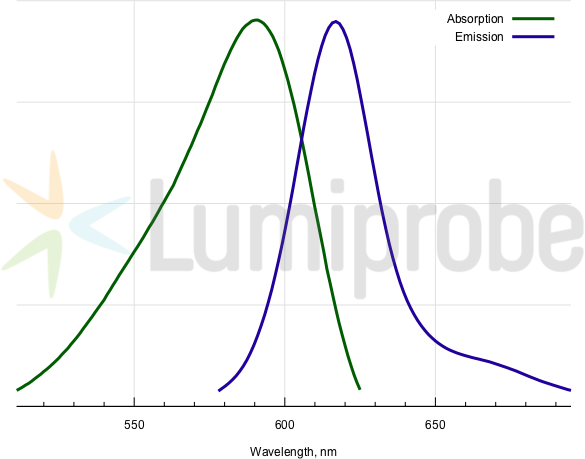BDP® TR NHS ester
This product is discontinued, and no longer available.
We recommend BDP® TR-X-NHS ester as a substitute
| Cat. # | Quantity | Price | Lead time | Buy this product |
|---|---|---|---|---|
| NO items of this product available in stock but you can submit request for bulk. | ||||

This product will be discontinued soon in favor of BDP TR X NHS ester. We may still have some material in stock (please see availability above).
BDP TR is a bright and photostable borondipyrromethene dye, which is especially suitable for microscopy applications. The dye has a long excited state lifetime, and is therefore is useful for fluorescence polarization assays. Its large two-photon cross section makes this dye useful for two-photon spectroscopy.
This NHS ester is an amine-reactive form of the dye.
Absorption and emission spectra of BDP TR

Customers also purchased with this product
sulfo-Cyanine5.5 carboxylic acid
Water-soluble far-red fluorescent dye sulfo-Cyanine5.5 in the form of free non-activated carboxylic acid. The dye is useful for calibration and as a non-reactive control.Biotin-PEG3-azide
Biotin azide is a reagent for click chemistry labeling with biotin, a well-known affinity probe to streptavidin.General properties
| Appearance: | dark blue-black crystals |
| Mass spec M+ increment: | 406.1 |
| Molecular weight: | 521.30 |
| CAS number: | 150152-65-1 |
| Molecular formula: | C25H18BF2N3O5S |
| IUPAC name: | Methyl {p-[4,4-difluoro-5-(2-thienyl)-3a,4a-diaza-4-bora-s-indacen-3-yl]phenoxy}acetate |
| Quality control: | HPLC-MS (95%), UV-Vis |
| Storage conditions: | Storage: 12 months after receival at -20°C in the dark. Transportation: at room temperature for up to 3 weeks. Avoid prolonged exposure to light. Desiccate. |
| MSDS: | Download |
| Product specifications |
Spectral properties
| Excitation/absorption maximum, nm: | 589 |
| ε, L⋅mol−1⋅cm−1: | 69000 |
| Emission maximum, nm: | 616 |
| Fluorescence quantum yield: | 0.9 |
| CF260: | 0.15 |
| CF280: | 0.19 |
Product citations
- Best, Q.A.; Haack, R.A.; Swift, K.M.; Bax, B.M.; Tetin, S.Y.; Hershberger, S.J. A Rainbow of Acridinium Chemiluminescence. Luminescence, 2021, 36(4), 1097–1106. doi: 10.1002/bio.4038
- Yao, J.; Huang, X.; Ren, J. In Situ Determination of Secretory Kinase Fam20C from Living Cells Using Fluorescence Correlation Spectroscopy. Talanta, 2021, 232, 122473. doi: 10.1016/j.talanta.2021.122473
BDP® is a trademark of Lumiprobe Corporation
This Product is offered and sold for research purposes only. It has not been tested for safety and efficacy in food, drug, medical device, cosmetic, commercial or any other use. Supply does not express or imply authorization to use for any other purpose, including, without limitation, in vitro diagnostic purposes, in the manufacture of food or pharmaceutical products, in medical devices or in cosmetic products.
The count of items is incorrect.












 $
$ 
